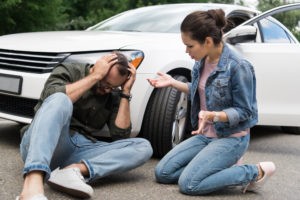When Do Pedestrians Have the Right of Way in California?
 According to the California DMV, an overwhelming 22% of traffic fatalities in California are pedestrians. Given the number of auto accidents that occur each day, that seems absurdly high. But there are several possible reasons for it, including the fact that the laws regarding pedestrian right of way can be confusing. So when do pedestrians have the right of way in California?
According to the California DMV, an overwhelming 22% of traffic fatalities in California are pedestrians. Given the number of auto accidents that occur each day, that seems absurdly high. But there are several possible reasons for it, including the fact that the laws regarding pedestrian right of way can be confusing. So when do pedestrians have the right of way in California?
Who Actually Has the Right of Way?
Pedestrians unambiguously have the right of way only within crosswalks at intersections, whether marked or unmarked, but this protects them only as long cross when it’s safe. California Vehicle Code §21950 specifically directs drivers to yield right of way to pedestrians in crosswalks at any intersection and to slow down as they approach a pedestrian in such a crosswalk, while exercising all due care to maintain their safety. Furthermore, the DMV advises drivers to give up their right of way to other vehicles or pedestrians if necessary to prevent collisions. The law doesn’t say to yield to pedestrians at an intersection only when you don’t have the light or a sign. You’re supposed to yield to them at all times.
But legally, this applies only to intersections, not everywhere — so pedestrians do not always have the right of way. The popular misconception that they do can lead to accidents when they try to cross anywhere but at an intersection. Even if they’re at an intersection, the crosswalk need not be marked, which can confuse a driver; this is why we recommend crossing only when you know it’s safe. Add to all that the fact that another law, CVC §21950 (b), forbids pedestrians from entering a crosswalk when a car is “so close as to constitute an immediate hazard.” How close is too close is a judgment call, and not all pedestrians know this law anyway.
What If the Pedestrian Is Partly at Fault?
Whether you’re a driver or pedestrian, exercise good judgment and flexibility when you’re on the road. And remember: the law may not find the driver either partially or completely at fault for a driver/pedestrian accident. The doctrine of comparative negligence allows all parties involved in an accident to be assigned some percentage of blame. It’s not uncommon for investigators to assign fault to both parties in a pedestrian/vehicle accident.
Situations in which the pedestrian could be found at least partially to blame include:
- jaywalking
- crossing against a “Do Not Walk” traffic signal
- entering a street while intoxicated
- walking along highways that prohibit pedestrian access.
Safety Tips for Both Drivers and Pedestrians
Pedestrians are typically aware of the dangers of mixing with auto traffic, even if they don’t exercise them. The most important thing to remember as a pedestrian is to keep on the lookout, constantly paying attention to your surroundings. Don’t listen to music on your earbuds, or watch something on your smartphone. Stay in the designated areas for pedestrians wherever possible.
The biggest responsibility for avoiding pedestrian accidents inevitably falls to drivers. We recommend acting very cautiously as you pass through pedestrian crossings. Whether or not you see anyone crossing or approaching, it can’t hurt to stop at the crosswalk, whether or not you have the light or a sign, or at least to slow down considerably. When someone does walk across, acknowledge their presence with eye contact and give them plenty of time to cross; don’t start creeping forward as they pass. Some people, like the elderly or the disabled, simply can’t cross quickly. And never try to pass a vehicle that’s braking or stopped for a pedestrian.
Contact Us Today to Learn More
Have you or someone you love suffered injury in a Southern California auto-pedestrian accident? Do you have legal questions related to such an accident? Feel free to contact Russell & Lazarus APC in Newport Beach, Long Beach, or Riverside.
